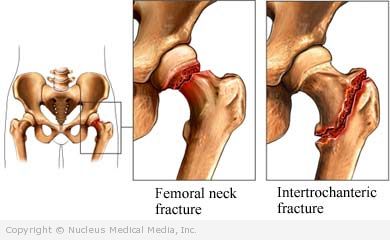Hip fracture – Definition
A hip fracture is a break in the thigh bone just below the hip joint. The hip joint consists of a ball at the top of the thigh bone (femur) and a rounded socket (acetabulum) in the pelvis. Most hip fractures occur in the neck of the femur 1-2 inches below the ball portion of the hip.
Hip fracture – Causes
Factors that may contribute to a hip fracture include:
- Falls (the most frequent cause of hip fractures)
- Osteoporosis — a bone-thinning condition that weakens all bones including the hip
- Motor vehicle accidents and other types of major trauma
- Stress fractures in athletes (rare)
- Bone conditions such as osteomalacia (rare)
- Bone tumors (rare)
Hip fracture – Risk Factors
A risk factor is something that increases your chance of getting a disease or condition.
- Previous hip fracture or history of falling
- Age: 65 years or older
- Sex: female (especially after menopause)
- Heredity
- Family history of fractures later in life
- Small-boned, slender body (low body weight)
- Caucasian or Asian race
- Others:
- Poor nutrition
- Deficient intake or absorption of calcium and vitamin D
- Low body weight
- Physical inactivity
- Weakness
- Poor balance and coordination
- Smoking
- Excessive alcohol use
- Chronic disease or fragile health
- Irregular heart beat or low blood pressure
- Arthritis
- Parkinson’s disease
- History of stroke
- Mental impairments including Alzheimer’s disease
- Problems with vision
- Certain medications which cause dizziness, drowsiness, or weakness
- Systemic cortisone or other steroids
- Thyroid disorder
- Heart failure
Hip fracture – Symptoms
Symptoms may include:
- Pain in the hip
- Difficulty or inability to stand, walk, or move the hip
- Abnormal appearance of the broken leg:
- Looks shorter
- Turns outward
Hip fracture – Diagnosis
The doctor will ask about your symptoms and how the injury occurred. A physical exam will then be performed.
Tests may include:
- X-ray — to determine exactly where the bone is broken and how far out of place the pieces have moved
- Bone scan or MRI scan — used if the fracture doesn’t show up on x-rays but symptoms indicate a fracture has occurred
Hip fracture – Treatment
The goal is to get you back on your feet again as quickly as possible while your broken bone heals. For older patients, staying in bed for even several days may lead to serious complications.
Treatment includes:
Prompt Emergency Treatment
- Taking all weight off the injured leg and immobilizing the fracture
- Checking vital signs such as blood pressure
- Treating problems such as internal blood loss
- Pain control with pain killers and other drugs
Surgery
Surgery is performed to set the broken bone and hold it in the correct position. This may involve:
- Inserting a surgical plate and screws at the fracture site
- Replacing the hip with a metal implant (prosthesis), which has a ball that fits into the hip socket and an attached stem which goes into the thigh bone to hold the implant in place
Physical Assistance
- Exercises or therapy to help you return to your normal level of activity
- A cane or walker as advised by your doctor
- Aid with activities of daily living until you can return to normal activity
If you are diagnosed with a hip fracture, follow your doctor’s instructions.
Hip fracture – Prevention
Early corrective action may help alleviate many of the factors that can lead to a hip fracture. Here’s what you can do:
- Eat a diet with nutrients for strong bones:
- Calcium — about 1000 milligrams daily but check with your doctor
- Vitamin D — 400-800 units a day
- Adequate protein intake
- Exercise (Ask your doctor before starting):
- Weight-bearing activities such as walking
- Strengthening exercises for both upper and lower extremities
- See your doctor if you are at risk for osteoporosis. Preventive medication may include:
- Hormone replacement therapy for women after menopause
- Biphosphonates
- Calcitonin
- Ask your doctor if any of your medications may contribute to:
- Bone loss
- Dizziness, drowsiness, or confusion
- Reduce falling hazards at work and home:
- Clean spills and slippery areas immediately.
- Remove tripping hazards such as loose cords, rugs, and clutter.
- Use non-slip mats in the bathtub and shower.
- Install grab bars next to the toilet and in the shower or tub.
- Put in handrails on both sides of stairways.
- Walk only in well-lit rooms, stairs, and halls.
- Keep flashlights on hand in case of a power outage.
- Get your eyes checked regularly.

